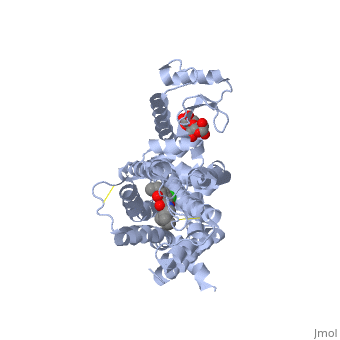Sandbox Reserved 383
From Proteopedia
| Line 20: | Line 20: | ||
*Nafadotride | *Nafadotride | ||
Two ligands that are associated with dopamine D3 receptor are 3-chloro-5-ethyl-N{[(2S)-1-ethylpyrrolidin-2-yl]methyl}-6-hydroxyl-2-methyloxybenzamide (ETQ on PDB) and maltose (MAL on PDB). ETQ binds to dopamine D3 receptor by Asp 110A and Phe346A. MAL binds by Asp 1020A, Glu 1022A, Glu1011A, and Leu1032A. 4 | Two ligands that are associated with dopamine D3 receptor are 3-chloro-5-ethyl-N{[(2S)-1-ethylpyrrolidin-2-yl]methyl}-6-hydroxyl-2-methyloxybenzamide (ETQ on PDB) and maltose (MAL on PDB). ETQ binds to dopamine D3 receptor by Asp 110A and Phe346A. MAL binds by Asp 1020A, Glu 1022A, Glu1011A, and Leu1032A. 4 | ||
| - | + | [[Image:Ligand|thumb|260px|left|<ref </ref>]] | |
==Diseases== | ==Diseases== | ||
Variations in the DRD3 gene is connected with essential tremor hereditary type 1 (ETM1). ETM1 is the most common movement disorder involving postural tremor of the arms, head, legs, body core, voice, jaw, and other facial muscles. This condition can be provoked by emotions, hunger, fatigue, and temperature extremes.3 Disorders that are linked to variations in the DRD3 gene include social phobia, Tourette’s syndrome, Parkinson’s disease, schizophrenia, neuroleptic malignant syndrome, attention-deficit hyperactivinty disorder (ADHD), and drug and alcohol dependence.5 | Variations in the DRD3 gene is connected with essential tremor hereditary type 1 (ETM1). ETM1 is the most common movement disorder involving postural tremor of the arms, head, legs, body core, voice, jaw, and other facial muscles. This condition can be provoked by emotions, hunger, fatigue, and temperature extremes.3 Disorders that are linked to variations in the DRD3 gene include social phobia, Tourette’s syndrome, Parkinson’s disease, schizophrenia, neuroleptic malignant syndrome, attention-deficit hyperactivinty disorder (ADHD), and drug and alcohol dependence.5 | ||
Revision as of 00:02, 1 December 2011
| This Sandbox is Reserved from September 14, 2021, through May 31, 2022, for use in the class Introduction to Biochemistry taught by User:John Means at the University of Rio Grande, Rio Grande, OH, USA. This reservation includes 5 reserved sandboxes (Sandbox Reserved 1590 through Sandbox Reserved 1594). |
To get started:
More help: Help:Editing. For an example of a student Proteopedia page, please see Photosystem II, Tetanospasmin, or Guanine riboswitch. |
|
Contents |
Introduction
Dopamine receptors are a class of metabotropic G protein-coupled receptors that are important in the central nervous system. Dopamine receptors are involved many neurological processes that comprise motivation, pleasure, cognition, memory, learning, and fine motor skills. There are five subtype dopamine receptors, D1, D2, D3, D4, and D5. The D3 receptor is a part of the D2-like family.
Function
Human dopamine D3 receptor is a protein that encoded by the dopamine receptor gene (DRD3). 1 The DRD3 gene codes for the D3 dopamine receptor that inhibits adenylyl cyclase through inhibitory G-proteins. This receptor is located in the brain, suggesting that the D3 receptor plays a role in cognitive and emotional functions.2 The human dopamine D3 receptor is membrane-bound and scattered in the cytoplasm. Receptor stimulation causes internalization of the receptors at the perinuclear areas. This is followed by the spreading of the receptors to the membrane. DRD3 is contained in lipid rafts of renal proximal tubule cells.3
Structure
Human dopamine D3 receptor is 64% helical and 1% beta sheet. The protein is composed of 20 helices and 3 beta sheet strands. The helices are made up of 312 residues and the bate sheets are made up of 9 residues. The entire protein consists of 481 residues.
Ligands
Many non-selective prescription drugs bind to the D3 receptor.6 Some agonist, agents that stimulate, dopamine receptors include:
- Amphetamine
- Dopaminergic
- Methamphetamine
Some antagonists, agents that inhibit dopamine receptors include:
- Bromopride
- Clebopride
- Itopride
- Nafadotride
Two ligands that are associated with dopamine D3 receptor are 3-chloro-5-ethyl-N{[(2S)-1-ethylpyrrolidin-2-yl]methyl}-6-hydroxyl-2-methyloxybenzamide (ETQ on PDB) and maltose (MAL on PDB). ETQ binds to dopamine D3 receptor by Asp 110A and Phe346A. MAL binds by Asp 1020A, Glu 1022A, Glu1011A, and Leu1032A. 4 [[Image:Ligand|thumb|260px|left|[1]

